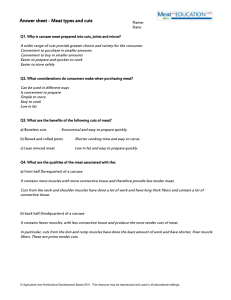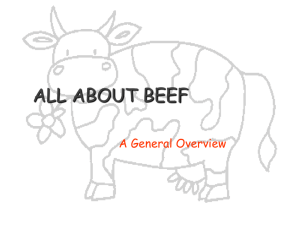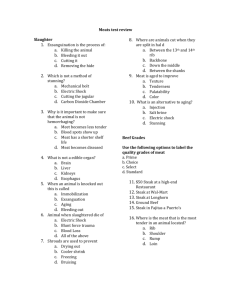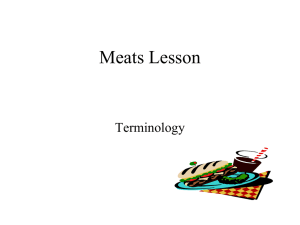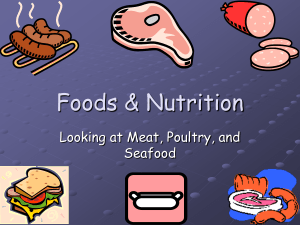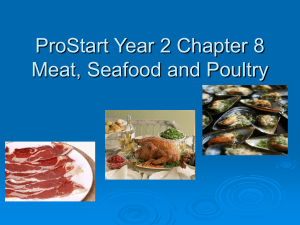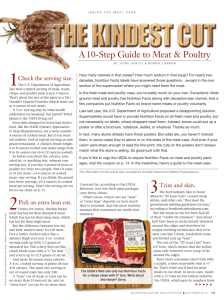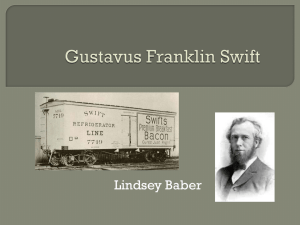Meat - Marblehead High School
advertisement
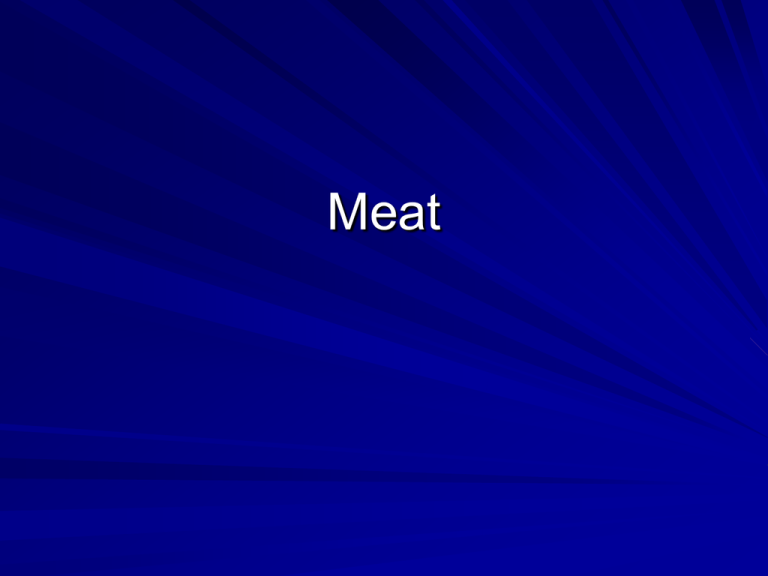
Meat Consumption Red meat consumption has decreased from 145 lb per person in 1970 to 116 lb per person in 2005 Beef consumption decreased from 84 lb in 1970 to 65 lb in 2005 Increase in use of mixtures containing mainly meat, poultry or fish (hamburgers, frozen dinners, chili) Decrease in use of separate cuts of meat such as steaks and roasts. Nutritive Value Protein - high quality Fats - mostly saturated, cholesterol Vitamins - good source of thiamin, riboflavin, niacin, vitamin A. Thiamin may be lost by heating Minerals - good source of iron, zinc, phosphorus. Minerals may be leached in cooking. Muscle Structure Muscle fibers are long thin structures ensheathed by a delicate membrane, the sarcolemma. Contractible matter made of myosin and actin which combine in contraction to form actinomycin. Myosin forms thick filaments and actin forms thin filaments. ATP provides energy for the process. _____ _____ _____ _____ _____ -------- --------- --------- --------- _____ _____ _____ _____ _____ -------- --------- --------- --------- Connective tissue Muscle fibers are bound by connective tissue, provides support. Endomysium - surrounds individual muscle cells Perimysium - surround a bundle of fibers Epimysium - surrounds bundles 1. Collagen - found in tendons. Hydrolyzed to gelatin in water and becomes tender. 2. Elastin - found in ligaments 3. Ground substance - mucopolysaccharides Amount of collagen in meat effects tenderness Fat 1. Fatty tissue or cover fat 2. Marbling - intramuscular fat Bone May help identify location on carcass. Tender cuts from back of animal, less active muscles. Examples: rib, t-bone, wedge. Less tender cuts from shoulder and hip, more active muscles. Examples: blade and round bone Tenderness of Meat Amount of connective tissue - collagen Fat, marbling - layer of fat insulates carcass, delaying chilling, thus metabolic changes occur. Some research shows no definite relation of fat to tenderness. Low voltage electrical stimulation - more postmortem metabolism Tenderizing Tenderizing Techniques 1. Enzymes - digest proteins and cause tenderization: papain, bromelin, ficin. Caused by general hydrolysis. 2. Mechanical - pounding, grinding, cubing. Accomplished by breaking fibers. 3. Acid - hydrolyzes proteins such as a marinade. 4. Salts – retain moisture and break down compounds surrounding muscles which causes the release of protein 5. Hydration of connective tissue by cooking in moisture Color Heme proteins: hemoglobin and myoglobin give red color. Combine reversibly with oxygen Fresh meat O2 Myoglobin <-> Oxymyoglobin <-> Metamyoglobin Purplish red Red Brown Metamyoglobin caused by oxidation of iron. Increased by denaturation of protein by freezing, salt, or UV light Cooked meat heat Oxymyoglobin ---> denatured globin denatured globin hemochrome Red Gray-Brown (tan) Cured meat nitrite heat Myoglobin ---> nitroso-myoglobin ---> Purplish red Red oxidation denatured globin <---> denatured globin nitrosoreduction nitrosohemochrome hemichrome Pink Brown Types of Meat Beef Tenderness depends on muscle, connective tissue, fat and bone. Color: purplish red or cherry red Veal More collagen and elastin than beef. Low fat but moist heat not always needed as animal is young, tender, and juicy. Color: lighter red, pinkish tinge around bones Lamb Young animal, tender. Better roasted than seared as high heat may toughen muscle tissue. Color: darker, deeper red than beef Pork Usually tender, best when roasted in open pan without water at 325 F. Color: dull rose Inspection and Grading USDA is responsible for inspection, grading, and setting of standards. Government inspection Required of all animals that enter interstate commerce. Animals inspected alive and at various stages in slaughtering process. Strategy includes: HACCP plan, written sanitation standard operating procedures, tests for Salmonella on raw meats and tests for generic E. coli. Grading Quality grade - based on maturity, character of lean (color, firmness, marbling). Yield grade - based on cutability which indicates the proportionate amount of salable retail cuts from a carcass. Storage Cold storage is required as meat is highly perishable. Best if stored below 36 F or at least refrigerator temperatures. Maximum refrigerator storage is 3-5 days, however, ground or variety meats should be used in 1-2 days. Should be wrapped as not to absorb odors from surrounding foods. Meat Cookery Dry heat - used on tender cuts of meat that contain a high proportion of muscle tissue. Examples: roasting or baking, broiling, pan-broiling, pan frying, deep fat frying. Moist heat - used for less tender cuts of meat that contain more connective tissue like collagen and elastin which soften in moisture. Examples: braising, stewing, boiling, pressure cooking and slow cooking. Cuts of Meat Most tender cuts Rib, T-bone or loin, and wedge or sirloin Medium tender cuts Chuck or arm - shoulder area, rump - hind leg area, and round Least tender cuts Flank, plate, brisket, neck, shank Bones and Retail Cuts of Meat Rib bone-rib steak, standing rib roast, rib eye roast T-bone-T-bone steak, NY strip steak, porterhouse steak, loin roast, loin chop, tenderloin Wedge bone-sirloin steak, sirloin tips Round bone-round steak, top round, bottom round, cubed steak Blade bone-blade steak, blade roast, shoulder steak, shoulder roast, arm roast, or arm steak Power Point Authors Jon Christiano & Dr. Jane Ross The University of Vermont Foods and Nutrition Basic Concepts of Food
